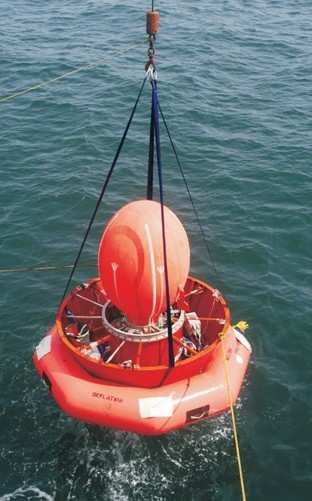Tue, Jan 23, 2007
Major Milestone For Country's Manned Space Program
India's Space Research Organization (ISRO) announced Monday it
has safely deorbited and recovered a capsule launched on January 10
from a facility north of the city of Chennai. The capsule was one
of four payloads aboard the rocket and was part of an effort by the
country to develop a manned spaceflight program.

The 1,210 pound Space Capsule Recovery Experiment (SRE) spent 11
days in orbit before splashing down in the Bay of Bengal yesterday.
(The above picture was taken during capsule recovery testing --
it's not from the actual SRE recovery).
A. Subramoniam, head of the team that designed and built the
capsule at ISRO, told the Sydney Morning Herald, "[It] landed in
the Bay of Bengal ... as per schedule. The mission is a great
success [and] a stepping stone to design and build our very own
reusable spacecraft, and eventually [carry out] manned missions
into space, too."
India's space agency has built and orbited communications
and remote-sensing satellites for years, but this mission marks a
first attempt at deploying a reusable spacecraft.
India's home-grown Polar Satellite Launch Vehicle --
dubbed PSLV-C7 -- carried the capsule aloft along with an
Indian mapping satellite, an Indonesian earth observation satellite
and an Argentinian educational satellite. The four objects were
lifted to a 395-mile polar orbit.

PSLV is ISRO's workhorse launch vehicle. It's a four-stage
rocket using a combination of solid and liquid propellants with a
total lift-off weight of nearly 300 tons. The agency boasts eight
consecutive successful launches with the booster since it
started service in 1994.
The SRE, whose primary mission was to aid India in developing
re-entry procedures and recoverable/reusable space technologies,
also carried two microgravity experiments into space and back to
earth.
Although ISRO officials say the country won't likely put an
astronaut in space before 2014, it says Monday's success will help
the country in its preparations for a 2008 unmanned moon
mission.
More News
Light Gun A handheld directional light signaling device which emits a brilliant narrow beam of white, green, or red light as selected by the tower controller. The color and type of>[...]
"The journey to this achievement started nearly a decade ago when a freshly commissioned Gentry, driven by a fascination with new technologies and a desire to contribute significan>[...]
Aero Linx: JAARS, Inc. For decades now, we’ve landed planes on narrow rivers and towering mountains. We’ve outfitted boats and vehicles to reach villages that rarely se>[...]
"Our driven and innovative team of military and civilian Airmen delivers combat power daily, ensuring our nation is ready today and tomorrow." Source: General Duke Richardson, AFMC>[...]
Aircraft Conflict Predicted conflict, within EDST of two aircraft, or between aircraft and airspace. A Red alert is used for conflicts when the predicted minimum separation is 5 na>[...]
 ANN's Daily Aero-Term (04.20.24): Light Gun
ANN's Daily Aero-Term (04.20.24): Light Gun Aero-News: Quote of the Day (04.20.24)
Aero-News: Quote of the Day (04.20.24) ANN's Daily Aero-Linx (04.21.24)
ANN's Daily Aero-Linx (04.21.24) Aero-News: Quote of the Day (04.21.24)
Aero-News: Quote of the Day (04.21.24) ANN's Daily Aero-Term (04.21.24): Aircraft Conflict
ANN's Daily Aero-Term (04.21.24): Aircraft Conflict




